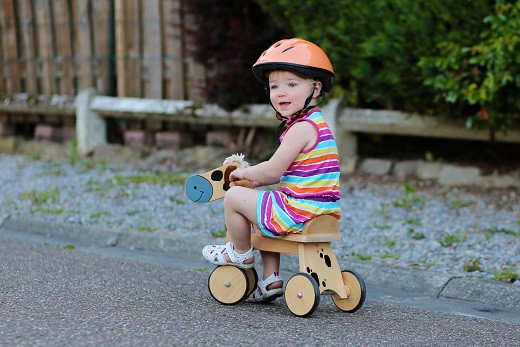The huge accomplishment of having learned to ride a bicycle is only the start of a world of independence for children. The question for parents of just how to initiate training your child to tackle a two-wheeler has gained a new answer in recent years with the introduction of the balance bike, which poses the challenge: Trike or Balance Bike?
The Tricycle’s History In Child Development
We can all admit to feeling a sense of assurance that our children won’t get hurt riding a trike. After all, three wheels equate to stability and mean we don’t have to be handy, literally, even though there are trikes with a giant handle attached to the back so mom can push her toddler around. Where is the independence in that? With a tricycle, there is little requirement for the child to work on balance because there is no need to. For most parents, there is a sense of relief in knowing little danger exists for their child on a trike. However, coordination takes a back seat while the focus is on pedaling and steering. Trikes have been known to topple over when the radial turns are too sharp. There is a degree of forcing the dynamic of turning when comfortably seated, and the mindset is determined. There is little incentive in getting up and moving the trike, until, of course, both trike and tyke end up in a pile on the ground.
Enter The Balance Bike
The balance bike is intentionally structured without pedals, a close-fitted seat, and sufficient distance allowing for the commensurate reach to the handlebars. The slight body-bend in the seated position when reaching to maneuver the bike encourages proper balance. Coordination is the primary goal with a balance bike. Children naturally use their feet to get the bike moving, sort of like Fred Flintstone in his famous foot-powered car. Children intrinsically adapt to raising their feet when going fully mobile and use them to stop or slow down. It is fascinating to see this all happen automatically. I remember feeling perplexed the first time I saw one of these tiny, two-wheeled bikes sans pedals. I wondered where the kid’s feet would go, but then I thought back on trying to teach my young niece to ride a two-wheeler. I remember wishing the pedals were not so “in the way” as we were getting started.
Breaking Down The Learning Curve
Once you witness the nearly liquid adaptation of your child on two wheels the moment they sit on a well-fitted balance bike, you begin to experience the virtual magic of human development. One of the reasons learning to ride a bicycle with the pedals and all the trimmings seems so challenging is that these combined elements engage separate areas of the brain. New movement and brain communication are best introduced by degree. As developmental pediatrician Dr. Tara Cancellaro puts it, “Balancing and pedaling skills come from different parts of the brain, so the child being able to work on one skill in isolation is helpful, especially for any children with motor delays. They will learn safer and faster when they can work on one thing at a time.”
Size Is Important
Fitting a balance bike to your child is like fitting for them for clothing. It is not as simple as assuming that a child can pick up any bike and roll with it. Some markets hoping to move a lot of their stock may advertise them as a “one-size-fits-all” line of bikes. This designation could not be farther from the truth. Children aged from 18-months to 5-years old do well learning to ride on a balance bike. Clearly, this presents a wide range of sizing. Tire size is a first basic measurement, quite simply, the smaller the tire, the smaller the child. They start with 10-inch wheels, however, as with the idea of onesies, this won’t outfit a child for very long before you find you need to go up to the next size. That would be 12-inch tires. Seat height is the next most critical indicator of how a bike will fit your child. Your child should be able to sit comfortably while still being able to have their feet push off the ground to propel themselves. For an endearing and encouraging view of how well a wee-one takes to a balance bike, check out this video here: If you want your child to achieve the best results from what I consider one of the most valuable tools in balancing physical and mental coordination, follow these easy-to-read guidelines in this handy balance bike sizing guide. Finally, consider the true magic of empowering your child with the tools that allow them to adapt naturally as they encounter their brave new world. I must admit that the balance bike represents one of the best tools I have come across that makes what is already a most rewarding experience for children an even greater journey of discovery and success. For a general overview of the process, check out this video on how to teach your child to ride a balance bike:
There is no greater joy than seeing your children succeed in their milestone achievements.
